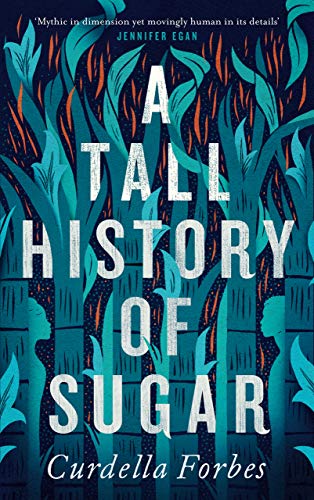Curdella Forbes, A Tall History of Sugar (©2019, Canongate 2020)
My father was a sugar farmer in North Queensland, on Mamu Country. My childhood was full of the sights, sounds, smells and language of sugar, but nowhere was that world reflected in the books I read or movies I saw. So now I seize greedily any movie, novel or poem that touches on it, from Summer of the Seventeenth Doll to A Girl in Australia (Bello onesto emigrato Australia sposerebbe compaesana illibata), a 1971 film starring Claudia Cardinale that sank without trace. Sugar Cane Alley (Euzhan Palcy 1983), set in Martinique, was the first film I saw that showed sugar farming from a non-settler point of view. (The analysis of colonisation in I Walked with a Zombie (1942) had gone over my head in the 70s.) Jean Devanny’s social-realist novel Sugar Heaven (1936) broadened my understanding of the history of my own town, my own family. If a book mentions bagasse (we used to call it megass), meaning the great flakes of ash that fill the sky during ‘the season’, I am wide open for whatever else it sends my way.
A Tall History of Sugar isn’t obviously about sugar at all, but it’s set mainly in Jamaica, beginning in 1958, four years before Jamaican independence, and its characters live in a world dominated by the colonial sugar industry. They suffer a number of wounds and afflictions that are somewhat magically caused by sugar. And there is bagasse (though I’m surprised to find on rereading this extract that the word itself isn’t there):
The cane is burning. Soot from fires twenty miles away floats through windows and doorways, soiling chenille bedspreads and the pristine white of lace doilies artfully strewn on tables. (Doilies are always
made in white, even during cane-crop time.)To the children, the soot flies like charred paper planes, or rat bats, birds of ill omen. Tumela women cover the beds with rags and remove the doilies, hiding the precious delicate things in cupboards until the cane is fully reaped. They put newspaper over the dressing tables. The newspaper will soil the tables black, but you won’t see the stain unless you wipe the table with a clean cloth or put something clean on the surface.
Sometimes people close their windows, but the soot seeps between the jambs and slats. And it is hard to be so confined, in a place where nobody locks a door, even at night, except in fear of things that
(Page 99)
are not human.
I don’t remember doilies or fear of things that are not human, but I recognise the rest in my bone-marrow, including the unlocked doors.
When the main male character first arrives in London, there’s a wonderful description of the colonised gaze, including this:
Covent Garden Mayfair Shepherds Bush Notting Hill Tyburn Tree Victoria Station Waterloo Trafalgar Square the River Thames. Everywhere was strange yet nowhere was strange, because he had seen it all before, in the books he had read at school, almost all of them from England, and then at last a few that were still from England but written by people from the place where he was from and these had opened like a light to him that first year he and Arrienne went to university …
Sometimes he had the strange sensation that he was leaking, not body fluids but ink, printer’s ink, that had made his skin porous over many years of exposure; he was poisoned in his bloodstream by other people’s words written down, and he couldn’t tell what the outcome would be, except that because of such words a foreign place had become more familiar to him than any place should be that he had never been.
(Page 177)
Another of the book’s charms is its use of Jamaican patois. Early on, Curdella Forbes dutifully translates non–West Indian speech, sometimes hilariously. For example, here an old woman comments to the mother of the book’s main male character, a child born with rare, and in this world uncanny, physical differences:
Miss Hildreth fell into the habit of prophesying his future. ‘Him gwine have a hard time, Rachel. Dat skin an dat hair gwine mek him way in dis world hard-hard. Hard travail. Mi si it. Ehn-hn.’ This unresolved body in which history has made ructions will make his pilgrimage difficult. This is what I have seen.
(Page 45)
But what’s the book about, you ask. Well, it’s the story of Moshe, a boy ‘born without skin’, found in bushes in a basket made of reeds, and big, dark-skinned Arrienne, exactly a year older, who becomes his protector from his first day at school. They are so close as children they communicate without speech. Their bond is deeper than romantic love, though there are some awkward sex scenes (awkward for them but not for the reader – Curdella Forbes’ telling is never less than brilliantly alive). They go on very different life courses: she to political activism at home in Jamaica, he to artistic success in Britain, but the bond endures. Their story plays out in the aftermath of the sugar plantations and slavery, manifesting in magic-realist wounds that bring torment when harvesting season begins, in characters’ engagement in the politics of post-independence Jamaica, in Moshe’s visit to Bristol where the slaver Edward Colston is celebrated as a great philanthropist.
I loved it.



Closer to home, you might like The Italian Girl by Rebecca Huntley, it’s the story of how her grandmother ran their sugar cane farm while her husband was interned during WW2. As you can see from my review, it has its flaws, but still, it may be of interest to you, see
https://anzlitlovers.com/2012/06/17/the-italian-girl-by-rebecca-huntley/
LikeLiked by 1 person
Thanks, Lisa. Your review had me at the train trip to Innisfail
LikeLiked by 1 person
Pingback: Rebecca Huntley’s Italian Girl | Me fail? I fly!